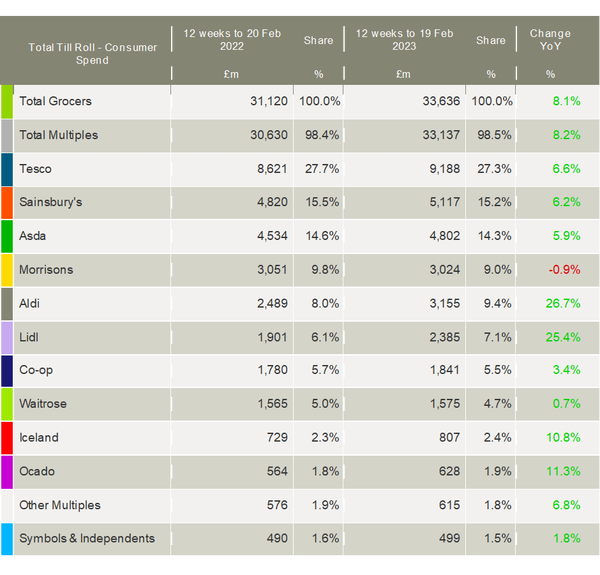Shoppers Continue To Flock To Discounters As Grocery Inflation Hits New Record High
Namnews, 28th February 2023
Grocery inflation hit 17.1% in the four weeks to 19 February, another record high for the figure measured by Kantar. This drove take-home grocery sales up by 8.8% during the four weeks and by 8.1% over the 12-week period, but volumes continued to decline, and shoppers headed to Aldi and Lidl to save money.
“Shoppers have been facing sustained price rises for some time now, and this February marks a full year since monthly grocery inflation climbed above 4%. This is having a big impact on people’s lives,” said Fraser McKevitt, head of retail and consumer insight at Kantar.
“Our latest research shows that grocery price inflation is the second most important financial issue for the public behind energy costs, with two-thirds of people concerned by food and drink prices, above public sector strikes and climate change. One quarter say they’re struggling financially, versus one in five this time last year. The numbers speak for themselves. If people don’t change how they buy their groceries, households are facing an £811 increase to their average annual bill.”
The data confirms that supermarkets and shoppers are continuing to adapt to manage rising prices. As they battle to protect their market share from the discounters, the traditional supermarkets have been focusing on their own-label ranges to offer better value. Sales of these lines were up by 13.2% this month, well ahead of branded products at 4.6%, a trend that Kantar noted shows little sign of stopping.
Recently shoppers have also been navigating shortages in the fruit and vegetable aisles. McKevitt commented: “Some supermarkets have been restricting the number of salad and vegetable packs customers can buy due to supply chain issues. Though not captured in this data set, we’ll be closely following the impact of these shortages on sales in the coming weeks. While 43% of all grocery baskets contain at least one fresh produce item, pack limits are unlikely to drastically affect consumers as we usually buy fruit and veg in smaller quantities. For instance, only 1% of tomato purchases last year involved more than three packs.”
Meanwhile, Aldi pushed its market share to a new record this period, hitting 9.4%. It remained the fastest-growing grocer, with sales up by 26.7% over the 12-week period. It was closely followed by Lidl, which increased sales by 25.4% and grew its share of the market to 7.1%.
Iceland also won share, taking 2.4% of the market, up from 2.3% last year after spending through its tills increased by 10.8% as consumers sought better value from frozen food.
Bucking the overall downward trend in online sales (-0.9%), Ocado put in a strong performance with sales growth of 11.3% delivering its largest-ever market share of 1.9%.
Tesco edged slightly ahead in the battle between Britain’s biggest retailers, with sales up by 6.6%. Sainsbury’s and Asda were just behind with sales rising by 6.2% and 5.9% respectively. Morrisons’ sales decline of 0.9% was its best performance since May 2021.
After launching a major price-cutting campaign, Waitrose returned to growth with its sales edging by 0.7%.

NAM Implications:
- Energy costs and grocery price inflation rank 1&2 in consumer concerns, with 25% struggling financially.
- This says it all re driving buying behaviour.
- With the mults pushing own label to counteract shoppers switching to discounters…
- …representing a double whammy for brands.
- Meanwhile, a combined discounter share of 16.5% (growing at the expense of the mults) is second only to Tesco’s 27.3%.
- Given these circumstances, can you afford to allow Aldi & Lidl to grow at 25%+
- Without your participation?
